
Food, food, food—who doesn’t love it?
Eating not only sustains us, but it’s also one of the most pleasant and gratifying sensory experiences we can engage in. No wonder enjoying meals together is a favorite occasion around the world.
South Africans are no different, of course. Our cuisine is diverse and we love getting together to eat, drink, and enjoy each other’s company. So, join us now for a wonderfully tasty investigation into South African foods!
 Table of Contents
Table of Contents
- Why Should You Know About South African Foods?
- South African Foods
- Typical But Lesser-Known Afrikaans Foods
- Afrikaans Food Vocabulary & Phrases
- Get Cooking in Afrikaans with AfrikaansPod101!
1. Why Should You Know About South African Foods?
Traveling, working, or planning to stay? After learning our language, few things would prepare you better for this adventure than getting to know our country’s people! This needn’t be a difficult task—studying our cuisine, for instance, can be helpful. It certainly depicts something about our collective identity and temperament.
- A. South African food is just as diverse as the country’s people. We house more than eleven nationalities in our Rainbow Country, which makes for a smorgasbord of variety. Never a dull moment!
- B. Our food also tends to be exceptionally rich in flavor, and sometimes very spicy. Some of the Malay- and Indian-influenced dishes, in particular, are not afraid to burn! Are we a “spicy” lot as a people? Well, looking at our history, we probably are. However, it’s also noticeable that, in our relatively short history, South Africans have never had it easy. At any given time, a part of the population was suffering some gruelling hardship or another, and today the country is still in the process of fixing that. Our history caused us to be tenacious, strong-willed, and highly opinionated. This means that we sometimes polarize. Our cuisine reflects this!
- C. That said, we’re not a bunch of fire-eaters at heart. Despite our occasional wildness, we ultimately prefer temperate to terrible. Looking at South Africa’s political history, for instance, it’s clear that we tend to avoid cataclysmic, all-destructive revolutions (sometimes just barely, but still!). Perhaps, due to the inhumane Boer wars with their concentration camps as well as British Field Marshal Kitchener’s ‘scorched-earth policy,’ we collectively abhor utter destruction. Our democracy and rectification of social injustices are still works in progress, but we’ve always been able to avoid becoming a truly demolished nation. So, while often strong and adventurous, our cuisine is not a difficult taste to acquire. You’re guaranteed to be won over by most of the flavors and textures—just as you will be by the country’s people!
- D. Need an easy conversation-starter with your Afrikaans friends? Well, South African food is it. Especially if you’ve tried some of our dishes and can praise their excellence, you will win over many a host’s heart with sincere compliments. Read on til the end for vocab and phrases that will impress your Afrikaans friends (or your AfrikaansPod101 tutor!).
As mentioned, South African cuisine is marked by its vast variety of influences. This is due to the many nationalities that have found their home in our country over the centuries. However, we won’t try to cover every culinary influence in this article; rather, we’ll focus on the main staples and a few lesser-known Afrikaans dishes.
2. South African Foods
Each population group’s cuisine has its distinct flavors and delicacies. Over time, many of these have cross-pollinated to become collective property.
The pre-colonial South African diet was mainly characterized by cooked grains, fermented milk, and stewed meat, supplemented by vegetables and fruit. These dietary trends have not disappeared and still form the base of countless South African recipes. Yet, one thing is sure: any South African foods list would be remiss if it omitted braaivleis (“barbeque meat”) and grain-based pap (“porridge”)!
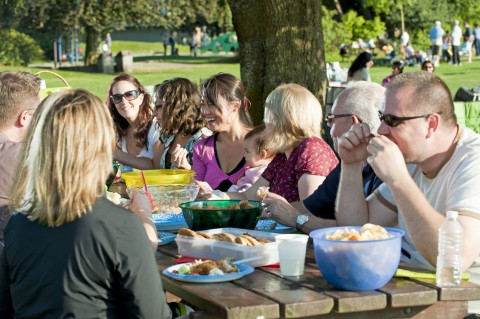
Suid Afrikaners is lief vir braai! (“South Africans love barbequing!”)
Braai-ing (“barbequing”) doesn’t need any introduction, as it’s a common cooking method worldwide and is discussed on nearly every website dealing with South African foods. Not to downplay its significance, though! For us, to braai together is as much a social custom as it is a way to prepare food. Read about the history, rituals, and paraphernalia of the Afrikaner barbeque on Wikipedia’s informative page.
Our braaivleis (“barbeque meat”) is almost always accompanied by pap and gravy or tomato relish, but that’s not the only way we enjoy it.
2.1 Pap (“Porridge” / “Grits”)
Very similar to American grits, the well-loved South African food pap still graces many tables in a great variety of dishes. Made of maize meal (or cornmeal), it’s usually white in color with a stiff and fluffy (or runny and soft) texture, and it’s a satisfying accompaniment to…well, almost any food.
South Africans love pap. We have it…
- …with sugar, milk, and a small lump of butter for breakfast.
- …as a fermented drink popularly called mageu.
- …in a delectable, enigmatic paptert (“porridge pie”), another braai side dish.
- …as an accompaniment to kaiings (leftover pork-meat or sheep’s tail fried until crispy—to die for!).
Yes, pap is quite versatile in its utility. And these are only a few of the recipes we’ve created over the centuries!
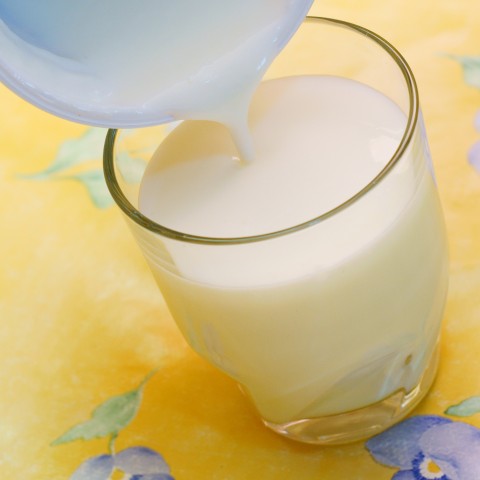
Thick, fermented drink being poured in a glass
Pap Recipes
Want to make this simple South African dish at home?
Watch slick food vlogger Funi teach the ins and outs of cooking this traditional, authentically South African food.
Also consider this easy recipe for a deliciously cheesy paptert, which is often a serious rival for the meat at braais! It’s not only moreish, but also very filling—so try to keep those portions small.
Or try out this recipe for an uncommon but tasty and attractive treat: the spicy pap bake. Replace the tinned chakalaka relish (another traditional South African food) by making your own. Siba Mtongana is the queen of chakalaka with this recipe, but it’s best to omit the tinned baked beans for the pap bake recipe. Warning: This is a pretty spicy dish! Obviously, you can adapt the spices to taste.
But hey, we’re not done with maize yet! Read on for another creative use of this vegetable under the Typical Afrikaans Dishes heading below. Next, though, is another traditional, wildly popular South African food that nearly every culture in the country has adopted and adapted: potjiekos (literally, “small-pot food”).
2.2 Potjiekos (“Small-Pot Food”)
South Africans love to gather around a fire for social meetings. And when we’re not braai-ing (“barbequing”), we make a potjie. To qualify as authentic potjiekos, this dish must comply with four rules:
- it must be prepared in a cast iron pot;
- it must be cooked on the glowing embers of an outside fire;
- it only gets stirred right before serving; and
- it usually takes a loooong time to cook (we’re talking hours here!).

‘n Potjie op die kole (“a little pot on the embers”)
As to what you want to cook in that pot—it’s entirely up to you! As said, different cultures have appropriated this cooking method; in some rural communities, this is how meals are prepared every day.
Over the years, some very outlandish potjies have seen the light of day, but the traditional ones are meat-and-veg dishes. And none can beat them!
Potjie Recipes
Potjiekos is a versatile dish, but it’s especially superb for cooking traditionally tough meats. The meat in these recipes will not only melt in your mouth, but also be juicier than you’ve ever enjoyed it.
For the basics on how to properly cook potjiekos, visit the informative Taste of Africa site. Don’t be fooled by the simplicity of the method—preparing food like this is an art! Still, we recommend you give it a try as this dish will likely steal your heart.
Wow your large family with this traditional lamb potjie in a tomato base. Slowly cooking the meat brings out its natural flavor and sweetness, which is deliciously conferred to the rest of the ingredients. Even the most stubborn, anti-vegetable carnivores are guaranteed to gobble up the veggies! The lamb can be replaced with mutton, but the meat’s cooking time will likely be longer.
Indian cuisine exerts a large influence on South African foods, as over a million Indians have made South Africa their home. That’s why we think you should consider this Indian-style recipe for a chicken curry potjie. Cooking this way allows for optimal development of all the flavors from the fragrant Indian spices. But this isn’t the only thing behind this dish’s seductive powers. Cooking in cast iron pots lends the ingredients a unique and recognizable flavor—you may never want to eat chicken any other way again!
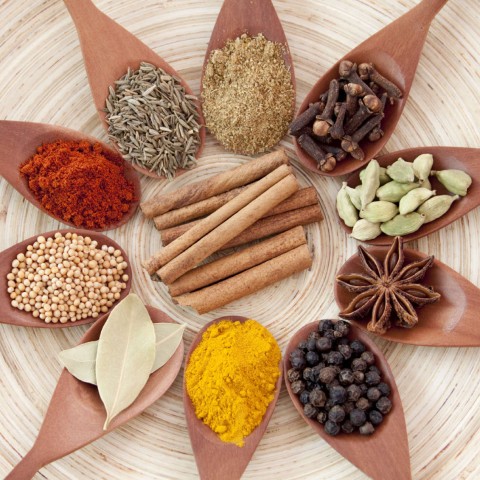
speserye om by ‘n potjie te voeg (“spices that can be added to a potjie“)
For an unusual pairing of seafood and chicken, consider this Surf and Turf potjie. The dish is prepared with rice already added and makes for a complete and devastatingly flavorsome meal.
Remember the outlandish versions we mentioned? Well, the following recipe is definitely so for traditional potjie-lovers, who are all carnivorous. Yet we added it to this recipe list because it’s guaranteed that vegetables have never tasted this good. Try local braai-master Jan Scannel’s vegetarian curry potjie to enchant your taste buds.

tradisionele potjiekos (“traditional potjiekos“)
Since this site is about Afrikaans, let’s now look at a few dishes the Afrikaners love in particular. We’re big on pap and potjiekos, of course, but the following dishes are unique to Afrikaner tables.
3. Typical But Lesser-Known Afrikaans Foods
Searching the Internet for Afrikaans foods draws up many lists that tend to comprise the same fare. Glance here, for instance, to get a pretty comprehensive list of South African foods. But there are plenty of traditional South African dishes that are rarely heard of outside the country. For example, a dish that’s not often mentioned but still commonly loved is melkkos (“milk food”).
3.1 Melkkos (“Milk Food”)
Melkkos is said to have developed from a thick Malaysian drink called bubur lambuk (“special porridge”), which is traditionally enjoyed to break the Islam fasting month of Ramadan. The Cape-Malays call the drink “boeber.” Traditionally made with sago, vermicelli, and sugar, it’s flavored with cardamom, cinnamon, and rose water. Similar drinks and puddings are popular around Asian and African countries, India, and other regions.

Geur melkkos met kaneelsuiker. (“Flavor melkkos with cinnamon sugar.”)
In Afrikaner homes, though, this dish is prepared a lot more simply. Melkkos is a hugely comforting and satisfyingly sweet, creamy porridge without any religious significance. Originally served as a dessert or pudding by the Afrikaner Boere (“Farmers”), it later became a meal in its own right. Kids adore it, and it’s relatively quick and easy to make.
Melkkos’ taste and creamy texture is very similar to the well-known (and beloved!) melktert (“milk tart”). Melktert, however, is not runny, is usually served cold, and tends to be much sweeter than melkkos. It’s also served as a dessert or tea-accompaniment rather than a meal.
This is an easy melkkos recipe you can make at home, just as it’s made and served in most Afrikaans homes. Adjust the amount of sugar and cinnamon to taste.
The next item on our South African food list is a very popular and commonly enjoyed Afrikaans tea with some superhero health properties.
3.2 Rooibostee (“Red Bush Tea”)
Fynbos or “fine bush” is a vegetation unique to South Africa, found mostly in the Western and Eastern Cape regions. Fynbos has a large degree of biodiversity, with rooibos (“red bush”) being a member of one of its plant families.
Rooibos leaves are used to make an herbal tea characterized by a beautiful red color (hence the name), and a distinct, sweet flavor.
We love this beverage not only for its tastiness, but also because it’s very healthy. In fact, few things soothe colic-y and allergic babies as well as black rooibostee (“red bush tea”)! It’s high in antioxidants and there’s even evidence that it’s good for heart health (though more clinical study is needed).
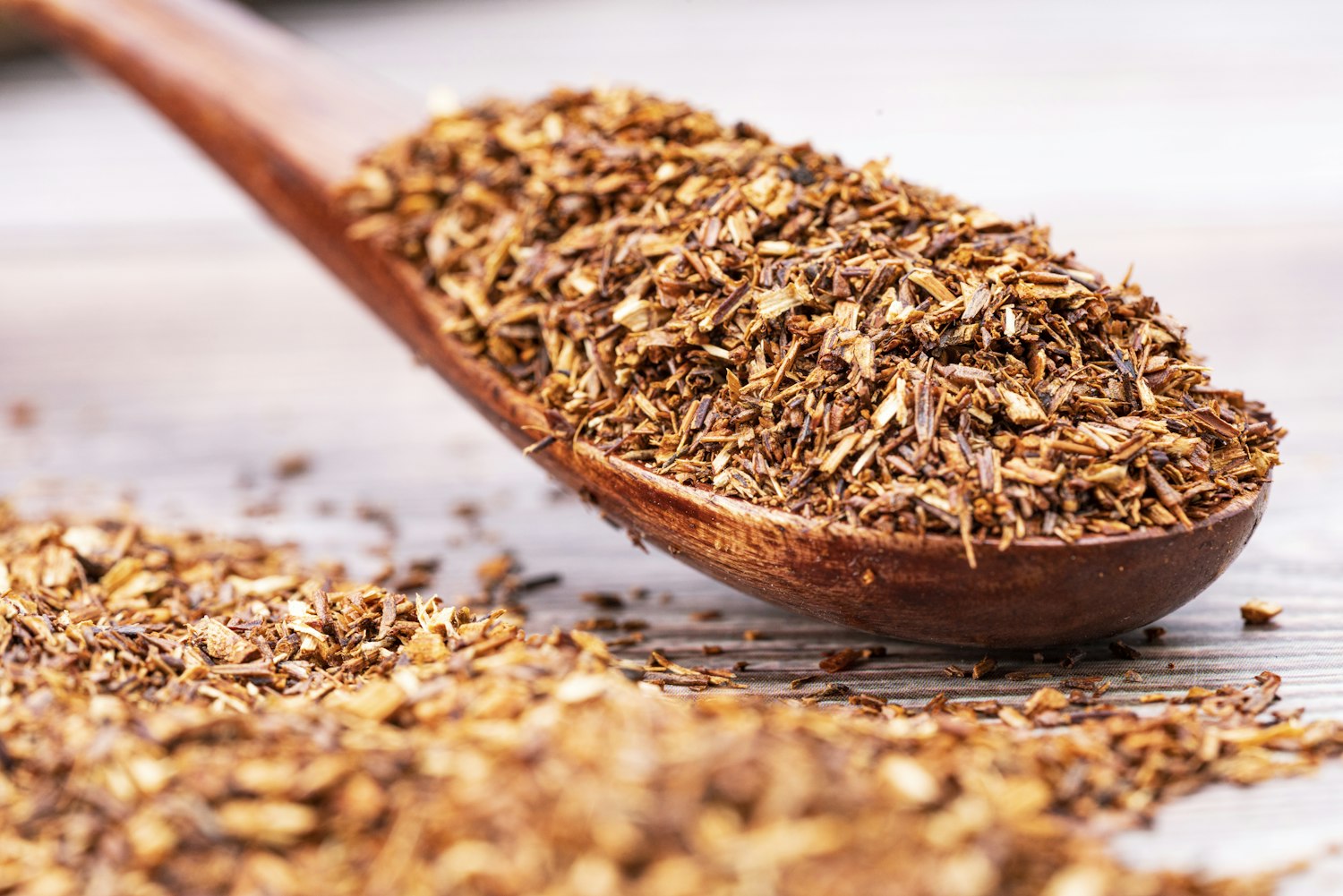
Rooibos tea leaves
Rooibostee is prepared like any other tea, by steeping it in just-boiled water for a few minutes. It’s taken with or without milk and sugar or honey and lemon.
However, it’s also a firm winner as an iced tea! Look, for instance, at this recipe with spices and fruit juice, ingredients which add to the tea’s health properties. Kids love its smooth, sweet taste and it’s certainly a perfect replacement for sugar-loaded fizzy drinks. Experiment by adding fresh herbs (mint is a favorite) or fruit (such as apples) to a pot of hot rooibostee. Let it cool down, refrigerate, and enjoy!
Rooibostee is also used to flavor food and it’s become a gourmet favorite of late. For very healthy snacks, for instance, try this delicious rooibos gummy recipe. Or change breakfast forever with this rich but super-healthy overnight rooibos and yoghurt chia porridge.
But that’s not all, folks! Your skin loves this tea, too. Rooibos extract forms the basis of a popular local skincare product that caters especially for sensitive skin. However, you can make your own rooibos toner in a jiffy! Brew some as usual and allow it to cool down, decant it into a clean container, and there you have it: soothing, brightening skin toner for daily use. Keep it in the fridge and prepare a fresh batch every week.

Hou jou vel gesond met rooibostee. (“Keep your skin healthy with rooibostee.”)
Rooibostee is particularly excellent for soothing acne and brightening a dull complexion. If the toner forms a reddish film when dry, just rinse your face with water before moisturizing.
Do you have raccoon-eyes due to stress or after a too-long night? No problem! Soak two cotton pads with the refrigerated tea, squeeze out any excess, and place them on your closed eyelids for a few minutes. You won’t believe the difference!
Another of the tea’s uncommon uses is making rooibos wine. Here, its wood replaces oakwood during the maturation process of the wine. It gives red wines a very unique, but distinctly rooibos, flavor.
3.3 Soet Mieliebrood / “Sweet Cornbread”
Nope, we haven’t forgotten the promised maize/corn recipe!
Us Afrikaners love our regular family dinners as well as watching major sports events together, and this almost always calls for a braai (“barbeque”). Rugby or football matches mysteriously seem much enhanced by braaivleis (“barbeque meat”) and this bread! A staple of authentic South African cuisine, it’s definitely for the sweet-toothed and makes an extremely popular pre-meal snack to soak up the (inevitable) alcohol in the stomach.
Soet mieliebrood (“sweet cornbread”) is close, but not 100% similar, to its American cousin with the same name.
Many other South African cultures have appropriated this easy bread recipe. This particular one is for baking in the oven, but seasoned braai-chefs love to bake it directly on the coals.
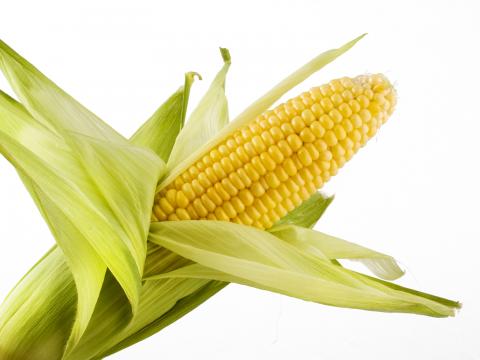
Corn on the cob
4. Afrikaans Food Vocabulary & Phrases
Now that you’re good and hungry for the must-try South African foods we covered, it’s time to take the next step. The following vocab and phrases will enhance your Afrikaans delivery in restaurants and at parties.
4.1 South African Food Vocabulary
- bobotie
- biltong (approximate: “beef jerky” – dried beef)
- beskuit (“rusks”)
- boerewors (literally: “Boere sausage”)
- frikkadelle (“meat balls”)
- hoenderpastei (“chicken pie”)
- koeksisters (literally: “cake sisters” – sweet, syrupy pastries)
- malvapoeding (literally: “marshmallow pudding” – cake-like dessert with sweet sauce)
- pampoenkoekies (“pumpkin fritters”)
- skilpadjies (literally: “small tortoises” – minced lamb’s liver wrapped in caul fat, barbequed)
4.2 South African Food Phrases

in die restaurant (“in the restaurant”)
4.2.1 In the restaurant
- Mag ek die spyskaart sien, asseblief? (“May I see the menu, please?”)
- Het julle ‘n wynlys? (“Do you have a wine list?”)
- Wat kan jy aanbeveel? / Wat stel jy voor? (“What do you recommend?”)
- Ek verkies vegetariese kos. (“I prefer vegetarian food.”)
- Brand hierdie baie erg? (“Does this burn a lot?” / “Is this very spicy?”)
- Watter dis is julle spesialiteit? (“Which dish is your specialty?”)
- Wat is julle spesiale dis vir vandag? (“What is your special dish of the day?”)
- Ek sal die wildsvleis probeer. (“I will try the game meat.”)
- Ek wil hierdie een hê, asseblief. (“I want this one, please.”)
- Kan ons apart betaal, asseblief? (“Could we pay separately, please?”)
4.2.2 At a party or private dinner
- Hierdie dis is fantasties! (“This dish is fantastic!”)
- Die slaaisous is heerlik. (“The salad dressing is delicious.”)
- Het jy koljander hier bygevoeg? (“Did you add coriander to this?”)
- Mag ek die sout kry, asseblief? (“May I have the salt, please?”)
- Ek sal die Merlot neem, dankie. (“I will have the Merlot, thank you.”)
- Nie vir my nie, dankie; ek bestuur. (“Not for me, thank you; I’m driving.”)
- Mag ek nog kry, asseblief? (“May I have more, please?”)
- Jy kan maar skep, ek is mal hieroor! (“You can dish up [a lot], I am crazy about this!”)
- Komplimente aan die kok! (“Compliments to the chef!”)
- Die maaltyd was werklik besonders, baie dankie. (“The meal was truly remarkable, thank you very much.”)
Supplement these with this list of Afrikaans compliments!
5. Get Cooking in Afrikaans with AfrikaansPod101!
We hope you’re salivating after reading this blog post. What do you think would be your favorite South African food? Or have you had the pleasure of tasting some traditional dishes already? Let us know in the comments below!
If you enjoyed this article, consider signing up immediately to learn about much more than just South African cuisine.
With over a decade of experience, we draw on our expert knowledge of online language learning techniques to offer you a unique learning space. Thousands of Afrikaans lessons are available at your fingertips, with free resources such as apps for Android, iPhone, iPad, and Kindle Fire.
With AfrikaansPod101, you can also create your own collection of vocab lists, learn the Afrikaans alphabet, and so much more!
We offer many enrollment options to suit your personal needs. Members can also enjoy features such as:
- Culturally relevant lessons
- A free online Afrikaans dictionary
- Access to Afrikaans Key Phrases
- Hundreds of lessons in different formats
Don’t hesitate—enroll now!
About the author: Christa Davel is a bilingual (Afrikaans and English) freelance writer and journalist, and is currently based in Cape Town, South Africa.










